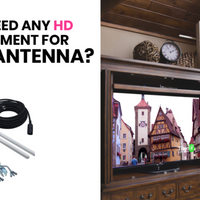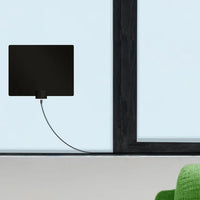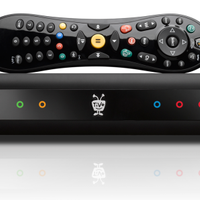When it comes to watching TV, there's a world of options available. But if you're looking for high-quality, free broadcasts, an HDTV antenna is a great way to go. This guide will walk you through the ins and outs of choosing, installing, and maintaining an HDTV antenna. So, let's dive in!
Why Choose an HDTV Antenna?
With the surge of streaming services, you might wonder if HDTV antennas are still relevant. The answer is a resounding yes! They offer free access to local channels, including news, sports, and entertainment. Plus, the quality is often superior to streaming services due to a stronger signal. Who doesn't want better quality for free? Additionally, HDTV antennas provide a reliable option for emergency situations when internet connections may be down. They also allow you to access broadcasts in real-time, which can be important for live events like sports games or breaking news.

HDTV antennas are easy to install and require no monthly subscription fees, making them a cost-effective choice for those looking to cut down on entertainment expenses.
So, if you're looking to supplement your streaming services or cut the cord altogether, consider investing in an HDTV antenna to enjoy free, high-quality local channels. They offer a convenient and reliable way to access a variety of content without breaking the bank.
Types of HDTV Antennas
HDTV antennas come in different forms to suit various needs and environments.
Indoor Antennas
If you live in an urban area, indoor antennas are perfect. They're small, easy to install, and don't require you to brave the elements on your roof. Just find a good spot near a window, and you're all set.
Outdoor Antennas
For those in rural areas or farther from broadcast towers, outdoor antennas might be necessary. These antennas offer the best reception and can pick up signals from miles away. However, they require installation on your roof or a pole.
Attic Antennas
A great middle ground between indoor and outdoor antennas is the attic antenna. If you have an attic space, it offers weather protection without the need to climb onto your roof. These antennas usually have good range and are relatively easy to install.
Key Features to Consider
When choosing an HDTV antenna, there are a few key features to keep in mind:

Signal Range
One of the most critical aspects to check is the signal range of an antenna. How far are you from broadcast towers? Make sure your antenna can pick up channels from that distance.
Frequency Bands
Antennas operate on different frequency bands, like VHF (Very High Frequency) and UHF (Ultra High Frequency). Ideally, your antenna should be compatible with both to access the full range of channels.
Amplifiers
Sometimes, the signal needs a little boost. That's where amplifiers come in handy. They enhance the received signal, helping you get clearer channels and more options.
Directionality
Antennas can be omnidirectional or directional. Omnidirectional antennas pick up signals from all directions, while directional antennas are more focused but require precise positioning. Consider your location and needs before deciding.
Installing Your HDTV Antenna
Once you've chosen the right antenna, it's time to install it!
Choosing the Right Location
Location is key when it comes to installing your antenna. Indoors, try near a window facing the broadcast tower. Outdoors, aim for the highest point on your roof with a clear line of sight. In the attic, position it near a vent or window for better reception.
Mounting the Antenna
Depending on your chosen antenna type, mounting may be as simple as sticking it to a wall or as complex as securing it to your roof. Follow the manufacturer's instructions for best results.
Connecting to Your TV
Once mounted, connect the antenna to your TV using a coaxial cable. It's pretty straightforward—just screw the cable into the designated port on your TV. Easy-peasy!
Scanning for Channels
Now that everything's set up, go to your TV's settings menu and scan for channels. It might take a few minutes, but once done, you'll have access to all available channels in your area.
Troubleshooting Common Issues
If you encounter issues with your HDTV antenna, here's how to troubleshoot them:
Weak Signal or No Reception
If your channels are fuzzy or you can't receive any, adjust the antenna's position. Sometimes even a slight change can make a big difference.
Interference and Noise
Nearby electronics or appliances can cause interference. Try moving your antenna away from these devices or reposition it for better reception.
Weather Impact
Heavy rain, snow, or wind can disrupt signals. If you notice issues during storms, consider an outdoor antenna cover or wait for the weather to pass.
Equipment Failure
Sometimes the problem is just faulty equipment. Check your cables for damage and make sure your TV's input settings are correct.
Maintaining Your HDTV Antenna
To keep your antenna working well, maintenance is key:
Cleaning and Protection
Keep your antenna clean and protected from the elements, especially outdoor ones. Wipe it down periodically and check for any signs of rust or damage.
Routine Inspections
Regularly inspect your antenna and its connections to ensure everything is working well. This proactive approach can save you headaches down the road.
Conclusion
So, there you have it—your guide to choosing, installing, and maintaining an HDTV antenna. With a little effort, you'll be enjoying free, high-quality broadcasts in no time. It's a worthwhile investment that pays off in the long run.
FAQs
Can I use an HDTV antenna in an apartment?
Absolutely! Indoor antennas are a perfect option for apartment dwellers. Just find a good spot near a window and scan for channels.
How do I know which direction to point my antenna?
Use an app or website that shows local broadcast tower locations. Point your antenna in that direction for the best reception.
How often should I scan for channels?
It's a good idea to scan every few months or whenever you notice changes in channel quality. This helps you catch any new channels that might become available.
Can I use one antenna for multiple TVs?
Yes, you can use a splitter to connect one antenna to multiple TVs. Just be aware that it may reduce signal strength, so consider an amplifier if necessary.
Do I need to ground my outdoor antenna?
Grounding an outdoor antenna is a smart safety measure. It protects your home from lightning strikes and other electrical surges. Check the manufacturer's guidelines for specific grounding instructions.






